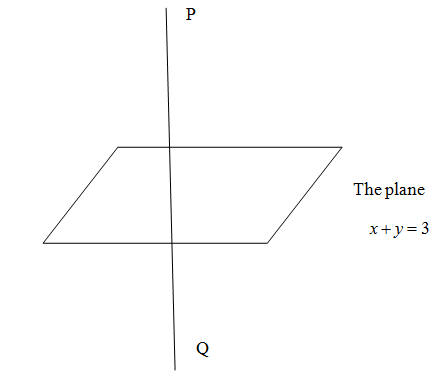
Let $P$ be a point in the first octant , whose image $Q$ is in the plane (that is the line segment $PQ$ is perpendicular to the plane $x+y=3$ and the midpoint of $PQ$ lies on the plane $x+y=3$) lies on the $z$-axis. Let the distance of $P$ from $x$-axis be 5. If $R$ is the image of $P$in the $xy$-plane then what is the length of $PR$ \[\]
Answer
573.3k+ views
Hint: Use the equation perpendicular line containing two points that are images of each other to find out the coordinate $P$. Then use the fact that two points that are image of each other are equidistant from the reflecting plane.\[\]
Complete step-by-step answer:

We can see from the image that the point $P$is reflected onto $Q$ by the plane $x+y=3$. If $P$ is an image of $Q$ then $Q$ is also an image of $P$. Let us denote the coordinates as $P\left( {{x}_{p}},{{y}_{p}},{{z}_{p}} \right)$ and $Q\left( {{x}_{q}},{{y}_{q}},{{z}_{q}} \right)$. We know that the perpendicular line containing $P$ and $Q$ where $P$ is the image of $Q$ with respect to the plane $ax+by+cz+d=0$ is given by
\[\dfrac{{{x}_{p}}-{{x}_{q}}}{a}=\dfrac{{{y}_{p}}-{{y}_{q}}}{b}=\dfrac{{{z}_{p}}-{{z}_{q}}}{c}=-2\left( \dfrac{a{{x}_{q}}+b{{y}_{q}}+c{{z}_{q}}+d}{{{a}^{2}}+{{b}^{2}}+{{c}^{2}}} \right)\]
As given in the body of the solution that the point lies $Q$ on the $z$-axis. So ${{x}_{p}}=0$ and ${{y}_{p}}=0$. The given equation of the plane is $x+y=3$. So $a=1,b=1,c=0,d=-3$. Putting these values in above equation
\[\begin{align}
& \dfrac{{{x}_{p}}-0}{1}=\dfrac{{{y}_{p}}-0}{1}=\dfrac{{{z}_{p}}-{{z}_{q}}}{0}=-2\left( \dfrac{1\cdot 0+1\cdot 0+0{{z}_{q}}-3}{{{1}^{2}}+{{1}^{2}}+{{0}^{2}}} \right) \\
& \Rightarrow {{x}_{p}}={{y}_{p}}=3,{{z}_{p}}={{z}_{q}} \\
\end{align}\]
So the coordinates $P$ are obtained as $\left( 3,3,{{z}_{q}} \right)$. It is also given that the point $P$ is at distance 5 from $x$-axis. The distance of any point is given by the formula $d=\sqrt{{{y}^{2}}+{{z}^{2}}}$. So ,
\[\begin{align}
& 5=\sqrt{{{3}^{2}}+{{z}_{q}}^{2}} \\
& \Rightarrow {{z}_{q}}=\sqrt{{{5}^{2}}-{{3}^{2}}}=4 \\
\end{align}\]
We have rejected the negative result because ${{z}_{q}}$ is a distance. Now the coordinates $P$ are obtained as $\left( 3,3,4 \right).$ We also know that the distance of any point from the $xy$-plane is equal to the $z$ coordinate of the point. So the distance $P\left( 3,3,4 \right)$ from the $xy$-plane is 4. \[\]
It is given that $R$ is the image of $P$ in $xy$-plane. Then R and $P$ are equidistant from $xy$-plane. Hence the length $PR=2\times 4=8$.\[\]
Note: The question tests the application distance formulas and reflection points. It is good to remember these formulas for example the point$\left( {{x}_{1}},{{y}_{1}},{{z}_{1}} \right)$ to plane $ax+by+cz+d=0$distance formula \[r=\left| \dfrac{ax+b{{y}_{1}}+c{{z}_{1}}+d}{\sqrt{{{a}^{2}}+{{b}^{2}}+{{c}^{2}}}} \right|\] and the line perpendicular to the reflecting plane $\dfrac{{{x}_{1}}-{{x}_{2}}}{a}=\dfrac{{{y}_{1}}-{{y}_{2}}}{b}=\dfrac{{{z}_{1}}-{{z}_{2}}}{c}=-2\left( \dfrac{a{{x}_{2}}+b{{y}_{2}}+c{{z}_{2}}+d}{{{a}^{2}}+{{b}^{2}}+{{c}^{2}}} \right)$ for shorter calculation.
Complete step-by-step answer:

We can see from the image that the point $P$is reflected onto $Q$ by the plane $x+y=3$. If $P$ is an image of $Q$ then $Q$ is also an image of $P$. Let us denote the coordinates as $P\left( {{x}_{p}},{{y}_{p}},{{z}_{p}} \right)$ and $Q\left( {{x}_{q}},{{y}_{q}},{{z}_{q}} \right)$. We know that the perpendicular line containing $P$ and $Q$ where $P$ is the image of $Q$ with respect to the plane $ax+by+cz+d=0$ is given by
\[\dfrac{{{x}_{p}}-{{x}_{q}}}{a}=\dfrac{{{y}_{p}}-{{y}_{q}}}{b}=\dfrac{{{z}_{p}}-{{z}_{q}}}{c}=-2\left( \dfrac{a{{x}_{q}}+b{{y}_{q}}+c{{z}_{q}}+d}{{{a}^{2}}+{{b}^{2}}+{{c}^{2}}} \right)\]
As given in the body of the solution that the point lies $Q$ on the $z$-axis. So ${{x}_{p}}=0$ and ${{y}_{p}}=0$. The given equation of the plane is $x+y=3$. So $a=1,b=1,c=0,d=-3$. Putting these values in above equation
\[\begin{align}
& \dfrac{{{x}_{p}}-0}{1}=\dfrac{{{y}_{p}}-0}{1}=\dfrac{{{z}_{p}}-{{z}_{q}}}{0}=-2\left( \dfrac{1\cdot 0+1\cdot 0+0{{z}_{q}}-3}{{{1}^{2}}+{{1}^{2}}+{{0}^{2}}} \right) \\
& \Rightarrow {{x}_{p}}={{y}_{p}}=3,{{z}_{p}}={{z}_{q}} \\
\end{align}\]
So the coordinates $P$ are obtained as $\left( 3,3,{{z}_{q}} \right)$. It is also given that the point $P$ is at distance 5 from $x$-axis. The distance of any point is given by the formula $d=\sqrt{{{y}^{2}}+{{z}^{2}}}$. So ,
\[\begin{align}
& 5=\sqrt{{{3}^{2}}+{{z}_{q}}^{2}} \\
& \Rightarrow {{z}_{q}}=\sqrt{{{5}^{2}}-{{3}^{2}}}=4 \\
\end{align}\]
We have rejected the negative result because ${{z}_{q}}$ is a distance. Now the coordinates $P$ are obtained as $\left( 3,3,4 \right).$ We also know that the distance of any point from the $xy$-plane is equal to the $z$ coordinate of the point. So the distance $P\left( 3,3,4 \right)$ from the $xy$-plane is 4. \[\]
It is given that $R$ is the image of $P$ in $xy$-plane. Then R and $P$ are equidistant from $xy$-plane. Hence the length $PR=2\times 4=8$.\[\]
Note: The question tests the application distance formulas and reflection points. It is good to remember these formulas for example the point$\left( {{x}_{1}},{{y}_{1}},{{z}_{1}} \right)$ to plane $ax+by+cz+d=0$distance formula \[r=\left| \dfrac{ax+b{{y}_{1}}+c{{z}_{1}}+d}{\sqrt{{{a}^{2}}+{{b}^{2}}+{{c}^{2}}}} \right|\] and the line perpendicular to the reflecting plane $\dfrac{{{x}_{1}}-{{x}_{2}}}{a}=\dfrac{{{y}_{1}}-{{y}_{2}}}{b}=\dfrac{{{z}_{1}}-{{z}_{2}}}{c}=-2\left( \dfrac{a{{x}_{2}}+b{{y}_{2}}+c{{z}_{2}}+d}{{{a}^{2}}+{{b}^{2}}+{{c}^{2}}} \right)$ for shorter calculation.
Recently Updated Pages
Why are manures considered better than fertilizers class 11 biology CBSE

Find the coordinates of the midpoint of the line segment class 11 maths CBSE

Distinguish between static friction limiting friction class 11 physics CBSE

The Chairman of the constituent Assembly was A Jawaharlal class 11 social science CBSE

The first National Commission on Labour NCL submitted class 11 social science CBSE

Number of all subshell of n + l 7 is A 4 B 5 C 6 D class 11 chemistry CBSE

Trending doubts
What is meant by exothermic and endothermic reactions class 11 chemistry CBSE

10 examples of friction in our daily life

One Metric ton is equal to kg A 10000 B 1000 C 100 class 11 physics CBSE

1 Quintal is equal to a 110 kg b 10 kg c 100kg d 1000 class 11 physics CBSE

Difference Between Prokaryotic Cells and Eukaryotic Cells

What are Quantum numbers Explain the quantum number class 11 chemistry CBSE




